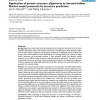Free Online Productivity Tools
i2Speak
i2Symbol
i2OCR
iTex2Img
iWeb2Print
iWeb2Shot
i2Type
iPdf2Split
iPdf2Merge
i2Bopomofo
i2Arabic
i2Style
i2Image
i2PDF
iLatex2Rtf
Sci2ools
BMCBI
2006
2006
Application of protein structure alignments to iterated hidden Markov model protocols for structure prediction
Background: One of the most powerful methods for the prediction of protein structure from sequence information alone is the iterative construction of profile-type models. Because profiles are built from sequence alignments, the sequences included in the alignment and the method used to align them will be important to the sensitivity of the resulting profile. The inclusion of highly diverse sequences will presumably produce a more powerful profile, but distantly related sequences can be difficult to align accurately using only sequence information. Therefore, it would be expected that the use of protein structure alignments to improve the selection and alignment of diverse sequence homologs might yield improved profiles. However, the actual utility of such an approach has remained unclear. Results: We explored several iterative protocols for the generation of profile hidden Markov models. These protocols were tailored to allow the inclusion of protein structure alignments in the proces...
Related Content
| Added | 10 Dec 2010 |
| Updated | 10 Dec 2010 |
| Type | Journal |
| Year | 2006 |
| Where | BMCBI |
| Authors | Eric D. Scheeff, Philip E. Bourne |
Comments (0)

